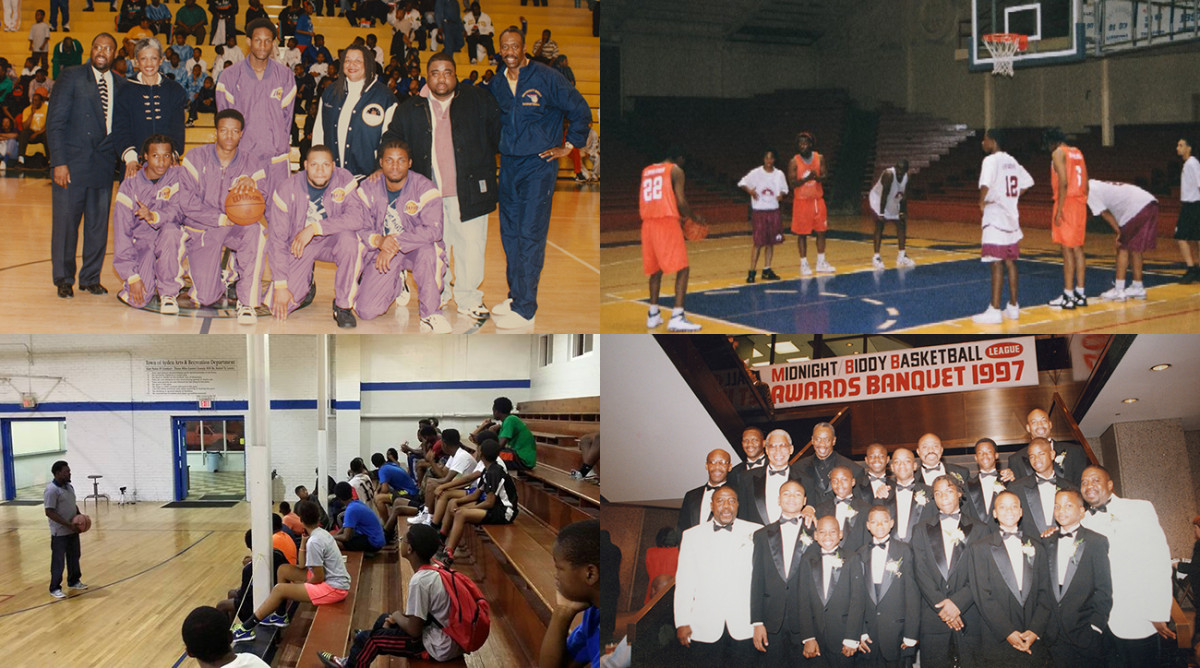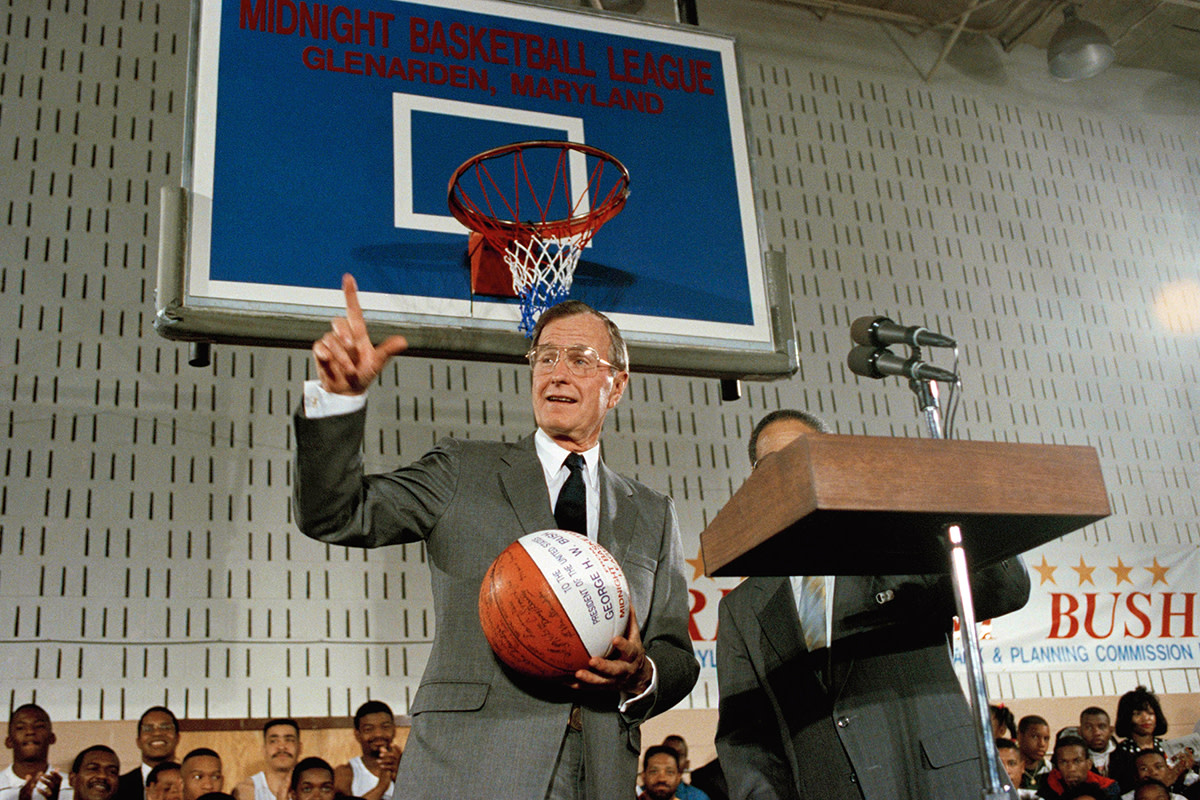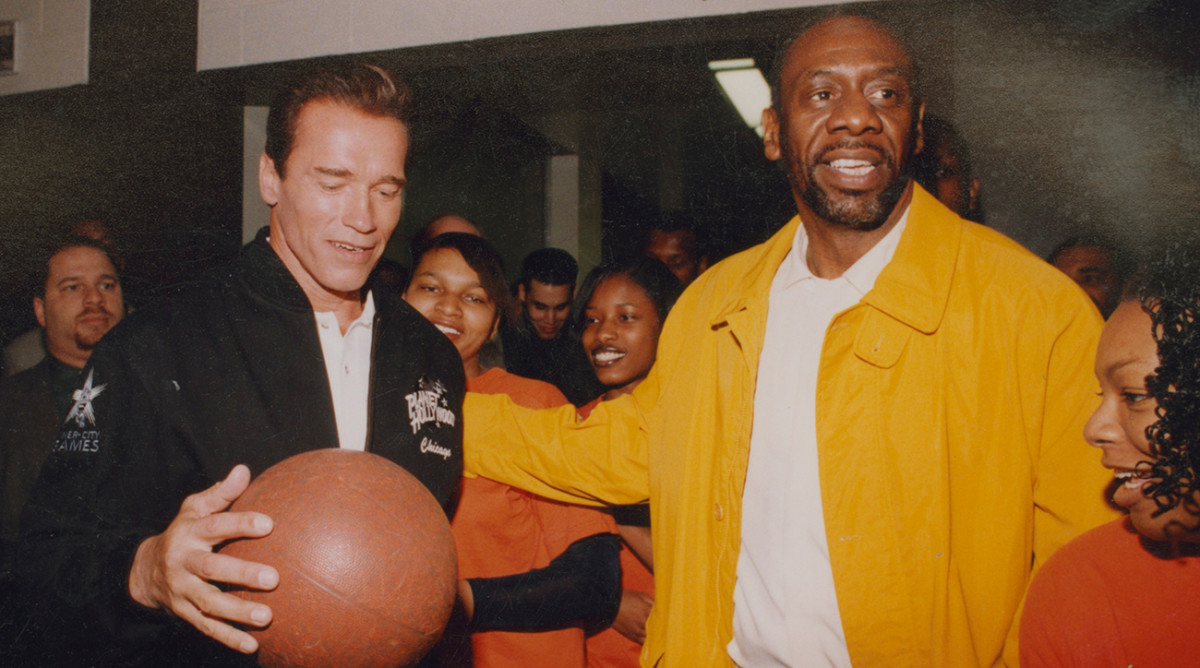Two decades later, the legacy of midnight basketball leagues is difficult to measure

Gil Walker reclines in a striped armchair in his bungalow on the South Side of Chicago, an orange tabby cat circling his feet. Dressed like a basketball player—pristine white Converse high-tops, navy sweats and a navy tee—he rolls up his pants leg to show the scars of a recent knee replacement. Walker’s buzz-cut hair is graying, but he sports the same thick mustache he did when he was the city’s unofficial youth basketball boss in the 1990s.
Touring Walker’s house on this Monday afternoon in May, it’s easy to feel transported back two decades. On the walls of the garage hang photographs of Walker with Bernie Mac, Al Gore and former Chicago mayor Richard Daley; in conversation he namedrops Arnold Schwarzenegger (Walker knew him before his Governator days) and Michael Jackson (yes, he once met Bubbles the chimp). In the sunroom, Walker opens a blue suitcase and pulls out a Shaq-era Orlando Magic warmup jacket, photo albums, pamphlets and a pair of red sneakers. For years he wheeled this suitcase of promotional material onto planes as he traveled the country speaking about his life’s most fulfilling work: Chicago’s midnight basketball program. From 1990 to ’98 Walker, the director of residential programs at the Chicago Housing Authority, ran the late-night hoops league that, like dozens of others that popped up across the country, brought together organized sports and social services for young men aged 17 to 25.
It’s been nearly 20 years since the last game in Chicago’s midnight league, discontinued when public funding dried up and sponsors lost interest, and Walker laments what’s become of his city. He points at young men walking home from school down Luella Street and wonders what will become of them, if they’re getting the life skills he tried to teach on the courts of Chicago’s squalid housing projects. The 68-year-old doesn’t claim that his modest sports-centric program tackled systemic problems. Instead, he aimed for young men caught up in the web of poverty and gave them, with a combination of faith and what he calls “itty-bitty money,” the opportunity to see a new game plan.
He wasn’t alone. Community leaders across the country, using hoops as a hook for social programming, started leagues modeled after a tiny operation that began in Glenarden, Md. But what made Chicago’s league memorable was its prominence and its promise—even if, 27 years after tip-off, its impact remains hard to measure.

In 1985, the town manager of Glenarden, a retired FAA worker named G. Van Standifer, became concerned with escalating crime rates in his area. Poring over police reports, he noticed a few trends: increased criminal activity in summer months, spikes between the hours of 10 p.m. and 2 a.m., and a high number of perpetrators between 17 and 22 years old. With parks closing early, drugs on the streets and few social services available, Standifer hit upon a diversion. “Opening the gyms at night, it would—one—keep the kids off the street,” says Eric Standifer, the founder’s son. “But for them to participate, they’d also have to participate in some constructive activity. It had to fulfill some need in the community.” In other words: This wouldn’t just be a hoops league. Participants would also have to participate in enrichment programs, from drug education workshops to career counseling. The league even offered partial scholarships to vocational schools for its players.
The elder Standifer, who passed away in 1992, incorporated the National Association of Midnight Basketball League Programs (NAMBLP) and trademarked its logo, ensuring any league that would want to use the name would also have to maintain a level of social services. For a few years the operation was small, serving fewer than 100 young men on a $40,000 grant from Prince George’s County. According Standifer, crime in the neighborhood decreased by 30% over the program’s first three years, a statistic he attributed to the program, even if it didn’t tell the whole story. “I played with guys who are in jail now, guys that didn’t do things that they were supposed to do,” recalls Elvis Pomells, now the owner of a cleaning service who was a 19-year-old point guard in the league’s inaugural season. “But then you’ve got good stories. Some of the guys I know are coaching youth squads and teaching kids how to be ballplayers.”
• Read all of Sports Illustrated’s best Where Are They Now? stories
A story about the relatively unknown Glenarden league led a section of the Sunday New York Times in February 1989, inspiring community leaders from other cities to visit and see what they could learn. By ’91, there were 12 leagues across the country, and President George H. W. Bush made midnight basketball one of his thousand points of light.
The following year Larry Gray, a former player at Huston-Tillotson College in Austin, Texas, launched a program in San Francisco’s Western Addition that served 300 young men in its first season, 90% of them unemployed. Basketball brought them to Ella Hill Hutch Community Center, but while there, they received much more. They got help with everything from getting driver’s licenses to earning their GEDs. “Oh man, at the time, that was the worst part of the whole thing for us,” recalls Howard Smith, one of the players. “We hated it. Larry was so strict that you could not play that night of basketball if you did not go to workshop. And we hated him for that."
In 1994, the San Francisco program produced its first college graduate—Smith—who had been mixed up in street crime before the program gave him a path to re-enroll to San Francisco State and join its football team.
By the mid-1990s, midnight basketball had reached its peak, serving more than 10,000 young men annually in nearly 50 cities. The programs’ aims were small, but as publicity grew, thanks to attention from first Bush and then President Bill Clinton, they became politicized. Midnight basketball came to symbolize everything conservatives disdained about Clinton’s 1994 crime bill: outsized spending on programs they viewed as pork barrel, rather than crime prevention. Even though the leagues accounted for just $40 million of the bill’s original $33 billion budget (0.12%), they became an oft-cited example of what critics believed to be irresponsible spending. Even after receiving their minimal funding once the bill passed, the leagues had become publicly demonized during the congressional debates, and by 2000 most programs had disappeared.
Even if the statistics didn’t bear out the effectiveness of midnight basketball, its champions still point to participants who were inspired to get an education, like Smith, or those who took the vocational skills they’d learned to start a business, like Pomells. Walker raised dozens of successful coaches through his leagues, including Lou Adams and Nick Irvin, both of whom won high school state titles in Chicago last spring. And there are the thousands of other men, who would credit the program with getting them off the streets, keeping them out of gangs or helping them find stable employment.

When Walker, who has lived on the South Side for most of his life, studied Standifer’s program, he knew that to bring it home, he’d need to add some glitz. This was, after all, Michael Jordan’s Chicago; the young men Walker wanted to reach were chasing hoop dreams and convinced they were a lucky break away from the NBA. Some, like Irvin, had the talent to go on to play Division-I college ball. Many others had the skill but not the grades.
On its opening night, the league, which ran on an $88,000 yearly budget, put on a star-studded show. Former Bills quarterback Jack Kemp, then Bush’s Housing Secretary, tossed a ceremonial opening tip-off at Malcolm X College on Chicago’s West Side. Daley followed suit. The first game was featured prominently in local newspapers, and Walker aspired to give players the trappings of a first-class college program: shoes, warmups, full uniforms, medical attention on the sidelines.
No two leagues were identical. Some were flashy, others gritty. Some held practices—in Chicago, there were two a week, along with two games, making participation a four-night weekly commitment—while others relied on players like Smith to rally teammates for workouts. Some cities ran several sessions a year; others stuck to summertime. In San Francisco, there were structured enrichment and career services, with a rotation of speakers. If a player failed to show for a session he was benched. In Chicago, enrichment was tied to practices. Miss one, and you’re out the next game—and games were also venues for player development. “[After games,] you sit in a circle,” says Walker, who often talks in the present tense about the league, “and the reason you sit in a circle is everyone’s even and equal. And we talk about some of the positive things that happened in the game and some of the negative things and how they relate to life.”
Walker has long believed that Chicago needs its own people—not outsiders with noble intentions—to solve its problems. “We (didn’t) need anyone to come into our community and tell us what's wrong with it,” he says. “We (didn’t) need ministers coming and talking ministry and telling us to be good people. I know we need jobs in our community. I know there's a whole lot of economic development that needs to go on. I know the school system needs to change. There are quite a few evils.” Midnight basketball wouldn’t create jobs or reform schools; it wouldn’t solve big-picture issues like race relations or police violence. Walker hoped simply to change young men’s attitudes on violence. From years of South-Side living, he knew he wouldn’t be able to talk his players out of the drug trade for good. Instead, he simply urged them not to sell to children and to work peacefully. “You're all shooting each other over dope,” he told them. “Over dope! Dope’s going to sell.”
How Allen Iverson finally found his way home
The Housing Authority operated leagues at four projects each year, rotating through 20 over its eight-year lifespan. Most developments had 16 10-man teams, and every league selected players through a draft. But before the league could be set up, a common understanding had to be reached. At every stop, Walker and his team held community meetings and even came to agreements with gang leaders. The gyms would be safe havens. One of Walker’s chief rules was that the league would shut down operations in any community where a fight broke out—even once.
The level of play could be electric. In the mid-1990s Terry Cummings, a Chicago native and former DePaul standout who was a two-time NBA All-Star, suited up for a game. The stands were packed, and the crowd erupted when somebody—a nobody—jammed over the 6'9" Cummings. Play was physical, scrappy, closer to playground ball. Referees kept players in line, though more than once, a bad call would be reversed from the sidelines—not because of any replay but because league officials worried that a wrong call could spark an altercation.
In the early days, fire marshals issued strict instructions about how to manage teeming crowds. But the commissioner, as Walker called himself, didn’t want the fire or police departments to have to enforce such rules. Although there were cops at every game, Walker asked that they do their business outside. He’d take care of discipline and logistics inside the gyms, and if the cops entered, it was for popcorn, soda or a few minutes of entertainment.
One night, Walker spotted a young man standing in the middle of his aisle. He asked him to move, and the man stared. He asked again. “Quit sweating me,” the man replied. “I’m going to f--- you up.” From the court, a player noticed the faceoff, and he ran off and pulled the objecting spectator aside. After the game, the man approached: “Commissioner, I apologize.” Later, Walker would find out he was a high-ranking gang leader and the player who’d intervened, one of his lieutenants.
“That was the key: Leave everything outside,” says Irvin, who played in the league as a teen and now coaches at Morgan Park High on the South Side. “We just want to focus on basketball and have a good time doing it. You had kids there. You had people in gangs playing in it. They had something to bring their kids to, to show them dad’s having fun.”
Walker wasn’t naïve. He saw players leaving guns at the door only to pick them up on their way out. Those four hours without weapons, though, he viewed as a victory. His gyms were sacred, and he was incensed one year when cops showed up at a Boys & Girls Club near Cabrini-Green, the northern-most project. They rolled in, arrested one of his players midgame, and left. The next day, Walker visited his police contacts. Too many of his players had records or gang ties; how was he supposed to work with troubled men if they thought his league was a trap? The police never made another in-game arrest.

Doug Hartmann, a professor of sociology at the University of Minnesota, has studied midnight basketball for nearly 30 years. He says there’s no evidence of a causal relationship between the program and drops in crime, though he commissioned a study in 2006 that found property-crime rates went down more in communities with midnight basketball than those without. “We don’t think [decreases in crime were] necessarily because of midnight basketball,” he says. “It was because those cities [with leagues] were cities with a lot more aggressive and proactive crime prevention programs.”
Even anecdotally, former players will admit the leagues’ impact was often felt only during the season. When hoops were in session, players were tired from games, focused on competing, resolved to put down weed and alcohol in order to train. Crime ticked down—but often temporarily. “The minute the program was on its break, here you go,” Darrell Dillard, a former San Francisco player, says. “Now you have guys with nothing to do again.”
Today, there are 25 active chapters under the NAMBL umbrella. Five major metro areas—Washington, the Bay Area, St. Louis, Austin and Nashville—are represented, as well as a handful of smaller cities like Tulsa; Petersburg, Va.; and Montgomery, Ala. In Chicago, Walker continued to work with younger players after the official league folded, but no similar program for young men ever took hold. He’s retired now, and he says he’s lost his platform. His work is left to his former players, such as Irvin and Adams.
Away from the NFL spotlight, financial ruin drove Clinton Portis to the brink of murder
This spring, Irvin’s team at Morgan Park won a state championship in a South-Side neighborhood with a crime rate 35% higher than the national average. On the West Side, Adams’s team at Orr Academy also won a title in another of the city’s roughest neighborhoods. Adams says he thinks of Walker almost daily, even 20 years after they met, even as the court where he played at the Robert Taylor Homes has been razed and the housing project’s inhabitants were bused to new homes across Chicago and the Midwest.
Ten miles north, Cabrini-Green, the site of that in-game arrest, is even less recognizable. It’s now the land of million-dollar condos, J. Crew and Crate & Barrel. But a handful of public housing residences remain, and even couched among the relative tranquility of the city’s North Side, the area is no stranger to stray bullets and sirens—reminders that even if the buildings have changed, many of the problems remain the same.
And so all that remains of midnight basketball in Chicago are Walker and his disciples—and a suitcase packed with uniforms and sneakers that haven’t smelled like sweat in decades. But they’re ready, should anyone want to lace up and give Walker’s old mission another go.
